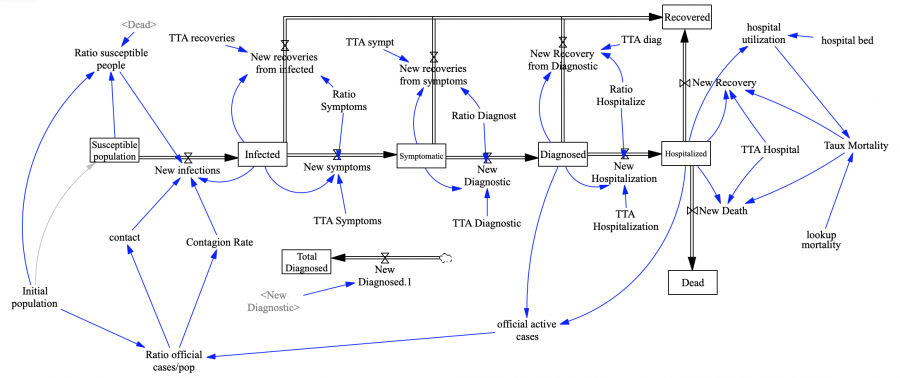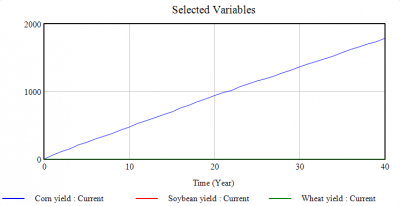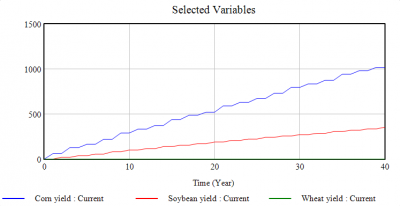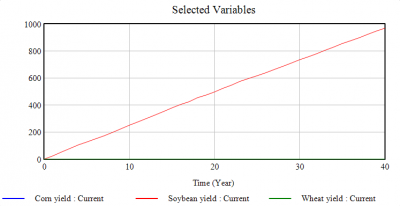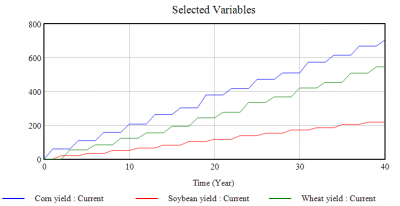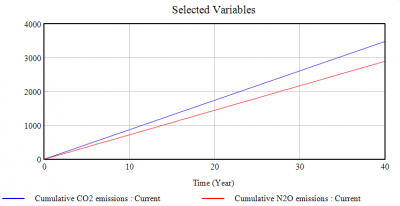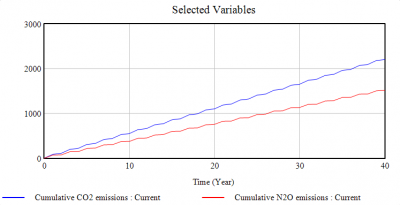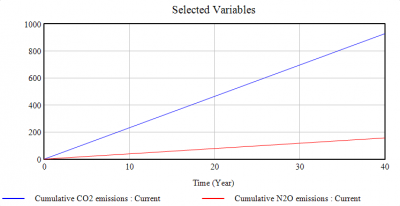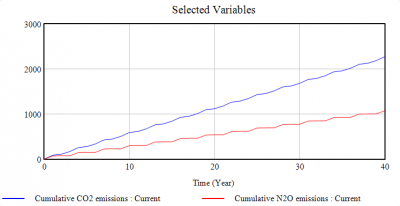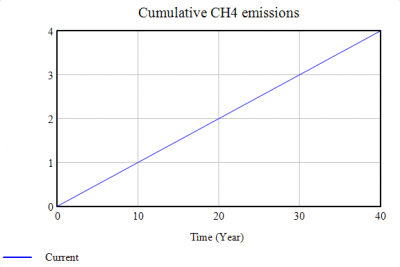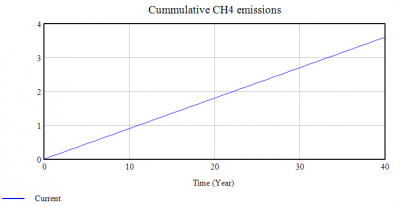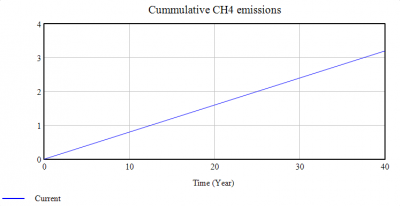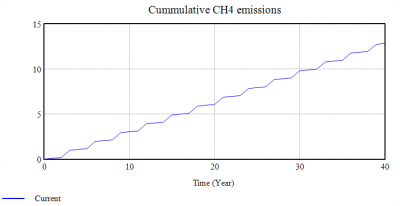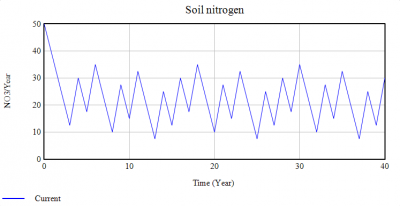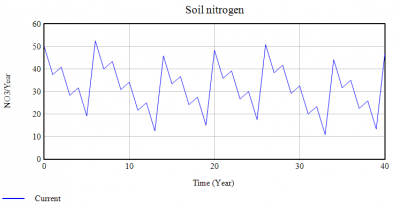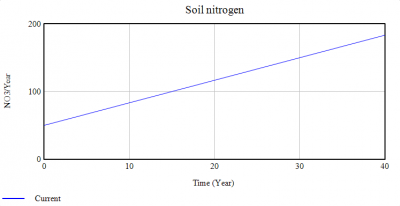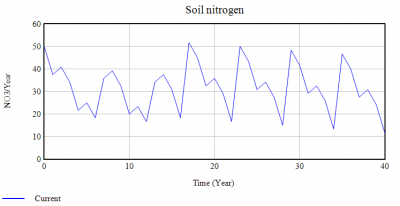Difference between revisions of "Impact of late lockdown and hospital capacity on 19-COVID spread"
(Created page with "Introduction =Problem definition= =Method= =Model= =Results= =Conclusion= =Code= =Problem definition= Crop rotation is based on growing a series of different types of c...") |
|||
| Line 33: | Line 33: | ||
Vensim modelling approach was selected due to dynamic behavior of the simulated system. | Vensim modelling approach was selected due to dynamic behavior of the simulated system. | ||
| + | |||
| + | Our model shows the evolution of the number of people who got infected by the covid-19 virus in | ||
| + | countries where the population have a high health care protection and where the government has | ||
| + | decided to make a decision about the virus propagation. The model will explain us how fast the | ||
| + | virus spreads itself and how political decisions can change the number of infected people at a | ||
| + | given point in time. The construction of our model is simple: at the beginning one person is | ||
| + | infected and will, then, infect other people. When you are infected many possibilities are open: | ||
| + | - You can be a healthy virus carrier. In that case you will not know that you have the virus and | ||
| + | after 19 days you will be recovered. | ||
| + | - After 5 days you get symptoms, but you do not have any important health problems, you will | ||
| + | recover in the next 14 days. | ||
| + | - After 5 days, you get symptoms and you are very sick and have respiratory problems, after 5 | ||
| + | more days, still feeling bad, you decide to go to the doctor to get a diagnosis. The doctor has than | ||
| + | two options: to send you back home, where you will recover after 9 more days or hospitalized you | ||
| + | the next day. | ||
| + | - The doctor had decided to hospitalize you, you then spend two weeks in intensive care, where | ||
| + | you will need artificial ventilation and 24-hour nursing care. You can then recover or unfortunately | ||
| + | die. The higher the hospital utilisation, the greater the probability to die. Indeed, if hospitals get | ||
| + | busier, the medical staff will be less available and health care quality might decrease. | ||
| + | When the number of diagnosed and hospitalised people (which are the official number of cases) | ||
| + | is greater than 3% of the population, the government will take decisions to slow down the spread | ||
| + | of the virus. This is to say that governments will take some measures, such as installing a forced | ||
| + | lockdown of the population to decrease the number of contacts per habitant. Moreover, such a | ||
| + | decision will have an impact of the population, which will be more aware of the situation and will | ||
| + | be more careful to not spread or contract the virus. So, the contagion rate as the number of contacts | ||
| + | per people will slow down. They will be less hospitalised people, that means less people in the | ||
| + | hospital, meaning a better service and so less people who die. | ||
=Model= | =Model= | ||
Following vensim model was developed based on the study. | Following vensim model was developed based on the study. | ||
| − | [[File: | + | |
| + | [[File:Model1.png|900px|thumb|center|COVID-19 pandemic in Switzerland Stock Flow Diagram]] | ||
== Variables == | == Variables == | ||
| − | === | + | ===Initial population=== |
| − | + | The Population of Switzerland can be found here: https://en.wikipedia.org/wiki/Demographics_of_Switzerland | |
| + | =8 500 000 | ||
| − | = | + | ===Ratio susceptible people=== |
| + | Decrease the susceptible people by the number of deaths due to the COVID-19. | ||
| − | = | + | =Susceptible population / (Initial population-Dead) |
| − | = | + | ===Susceptible population=== |
| + | Deacrease the susceptible population by the number of new infections. | ||
| − | = | + | =-New infections |
| − | |||
| − | = | + | ===contact=== |
| + | '''Lockdown:''' ''Function IF THEN ELSE that bring the number of new people you meet (contact) from 5 to 0.05 if the ratio exceed 0.015%'' | ||
| + | =IF THEN ELSE("Ratio official cases/pop"> 0.00015, 0.05 , 5 ) | ||
| − | === | + | ===Contagion Rate=== |
| − | '' | + | '''Lockdown:''' ''contagion rate: IF THEN ELSE that bring the contagion rate from 0.1 to 0.075 if the ratio exceed 0.015%. Function of the awareness in the population (washing more often their hands if lockdown)'' |
| − | = | + | =IF THEN ELSE("Ratio official cases/pop" > 0.00015 , 0.075 , 0.1 ) |
| − | === | + | ===New infections=== |
| − | + | It represent the new number of people infected each day. | |
| − | = | + | =contact*Infected*Ratio susceptible people*Contagion Rate |
| − | === | + | ===Infected=== |
| − | + | It represent the stock of the new people infected. We start the model with 1 infected people. | |
| − | = | + | =New infections-New recoveries from infected-New symptoms ///// Initial value: 1 |
| − | = | + | ===New recoveries from infected=== |
| + | It represent the number of people without symptoms and they go in the recovered stock after 19 days. | ||
| − | = | + | =((1-Ratio Symptoms)*Infected)/TTA recoveries |
| − | |||
| − | = | + | ===New symptoms=== |
| + | It represent the number of new people that develop symptoms during 5 days before going to the symptomatic stock. | ||
| − | = | + | =(Infected*Ratio Symptoms)/TTA Symptoms |
| − | === | + | ===Ratio Symptoms=== |
| − | + | The ratio of people who develop some symptoms. | |
| − | + | =0.2 | |
| − | |||
| − | =0 | ||
| − | |||
| − | |||
| − | |||
| − | + | ===Symptomatic=== | |
| − | + | The stock of people symptomatic. | |
| − | |||
| − | |||
| − | = | + | =New symptoms-New Diagnostic-New recoveries from symptoms |
| − | |||
| − | + | ===New recoveries from symptoms=== | |
| − | + | It represent the number of people that have symptoms but that were not to the doctor, after 14 they are in the recovered stock. | |
| − | = | + | =(1-Ratio Diagnost)*Symptomatic/TTA sympt |
| − | |||
| − | + | ===New Diagnostic=== | |
| − | + | It represent the number of new people that are diagnosed each day, they stay 3 days before having the diagnostic. | |
| − | = | + | =Symptomatic*Ratio Diagnost/TTA Diagnostic |
| − | = | + | ===Ratio Diagnost=== |
| + | the ratio of people that are diagnosed by a doctor. | ||
| − | = | + | =0.4 |
| − | = | + | ===Diagnosed=== |
| + | the stock of people that are diagnosed by a doctor | ||
| − | = | + | =New Diagnostic-New Hospitalization-New Recovery from Diagnostic |
| − | = | + | ===New Recovery from Diagnostic=== |
| + | It represent the number of people that are diagnosed and not sent to the hospital. they stay 9 days before going in the Recovered stock. | ||
| − | = | + | =(1-Ratio Hospitalize)*Diagnosed/TTA diag |
| − | |||
| − | = | + | ===New Hospitalization=== |
| + | It represent the number of people that are diagnosed and sent to the hospital. they stay 1 day before being sent. | ||
| − | = | + | =(Diagnosed*Ratio Hospitalize)/TTA Hospitalization Ratio Hospitalize |
| − | = | + | ===Ratio Hospitalize=== |
| − | + | the ratio of people that are Hospitalized. | |
| − | == | ||
| − | |||
| − | |||
| − | |||
| − | |||
=0.3 | =0.3 | ||
| − | === | + | ===Hospitalized=== |
| + | The stock of people that are hospitalized before being Recovered or Dead. | ||
| − | = | + | =New Hospitalization-New Death-New Recovery |
| − | === | + | ===New Recovery=== |
| + | The number of people that recover each day from the hospitalization. It depends from the Mortality Rate which is depend from the hospital utilization (capacity or number of beds...). | ||
| − | = | + | =((1-Mortality Rate)*Hospitalized)/TTA Hospitalization |
| − | === | + | ===New Death=== |
| + | The number of people that die each day from the hospitalization. It depends from the Mortality Rate which is depend from the hospital utilization (capacity or number of beds...). | ||
| − | = | + | =(Hospitalized*Mortality Rate)/TTA Hospitalization |
| − | === | + | ===hospital bed=== |
| + | The number of bed in Switzerland 356 beds for 100k people with 8.5M people it gives that number: https://www.swissinfo.ch/eng/coronavirus-crisis-_has-switzerland-got-enough-hospital-beds--/45671704 | ||
| − | = | + | =30260 |
| − | |||
| − | =0. | + | ===hospital utilization=== |
| + | The utilization of the hospital we assume that there is already 8260 beds used for patient outside the covid pandemic. The more the hospital is used (from 0 to 100%) the more the greater the probability to die. Indeed, if hospitals get | ||
| + | busier, the medical staff will be less available and health care quality might decrease | ||
| + | =(Hospitalized/(hospital bed - 8260)) | ||
| − | === | + | ===lk mortality=== |
| − | |||
| − | = | + | =[(0,0)-(1000,0.3)],(0,0.05),(0.8,0.05),(0.9,0.1),(1,0.15),(1.2,0.2),(10,0.2),(1000,0.2) |
| − | === | + | ===Mortality Rate=== |
| − | |||
| − | = | + | =lk mortality (hospital utilization) |
| − | === | + | ===Dead=== |
| − | |||
| − | = | + | =New Death |
| − | === | + | ===Recovered=== |
| − | |||
| − | = | + | =New recoveries from infected+New recoveries from symptoms+New Recovery+New Recovery from Diagnostic |
| − | === | + | ===official active cases=== |
| − | |||
| − | + | =Diagnosed+Hosptitalized | |
| − | |||
| − | |||
| − | |||
| − | |||
| − | === | + | ===Ratio official cases/pop=== |
| − | |||
| − | = | + | =official active cases/ Initial population |
| − | === | + | ===New Diagnosed.1=== |
| − | |||
| − | = | + | =New Diagnostic |
| − | === | + | ===Total Diagnosed=== |
| − | |||
| − | = | + | =New Diagnosed.1 |
| − | === | + | ===TTA recoveries=== |
| − | |||
| − | = | + | =19 |
| − | === | + | ===TTA Symptoms=== |
| − | |||
| − | = | + | =5 |
| − | === | + | ===TTA sympt=== |
| − | |||
| − | = | + | =14 |
| − | === | + | ===TTA Diagnostic=== |
| − | |||
| − | = | + | =5 |
| − | === | + | ===TTA diag=== |
| − | |||
| − | = | + | =9 |
| − | === | + | ===TTA Hospitalization=== |
| − | = | + | =1 |
| − | === | + | ===TTA Hospital=== |
| − | = | + | =14 |
| − | === | + | ===Number of rotated crops=== |
| + | ''Input constant variable which can be changed based on crop strategy. Range <1,3>.'' | ||
| − | = | + | =1 (in case of CCC and SSS strategies) |
| − | |||
| − | |||
| − | |||
| − | |||
| − | |||
=Results= | =Results= | ||
Revision as of 16:28, 7 January 2021
Introduction
Contents
- 1 Problem definition
- 2 Method
- 3 Model
- 4 Results
- 5 Conclusion
- 6 Code
- 7 Problem definition
- 8 Method
- 9 Model
- 9.1 Variables
- 9.1.1 Initial population
- 9.1.2 Ratio susceptible people
- 9.1.3 Susceptible population
- 9.1.4 contact
- 9.1.5 Contagion Rate
- 9.1.6 New infections
- 9.1.7 Infected
- 9.1.8 New recoveries from infected
- 9.1.9 New symptoms
- 9.1.10 Ratio Symptoms
- 9.1.11 Symptomatic
- 9.1.12 New recoveries from symptoms
- 9.1.13 New Diagnostic
- 9.1.14 Ratio Diagnost
- 9.1.15 Diagnosed
- 9.1.16 New Recovery from Diagnostic
- 9.1.17 New Hospitalization
- 9.1.18 Ratio Hospitalize
- 9.1.19 Hospitalized
- 9.1.20 New Recovery
- 9.1.21 New Death
- 9.1.22 hospital bed
- 9.1.23 hospital utilization
- 9.1.24 lk mortality
- 9.1.25 Mortality Rate
- 9.1.26 Dead
- 9.1.27 Recovered
- 9.1.28 official active cases
- 9.1.29 Ratio official cases/pop
- 9.1.30 New Diagnosed.1
- 9.1.31 Total Diagnosed
- 9.1.32 TTA recoveries
- 9.1.33 TTA Symptoms
- 9.1.34 TTA sympt
- 9.1.35 TTA Diagnostic
- 9.1.36 TTA diag
- 9.1.37 TTA Hospitalization
- 9.1.38 TTA Hospital
- 9.1.39 Number of rotated crops
- 9.1 Variables
- 10 Results
- 11 Conclusion
- 12 Code
- 13 References
Problem definition
Method
Model
Results
Conclusion
Code
Problem definition
Crop rotation is based on growing a series of different types of crops in the same area in sequential seasons. The planned rotation may vary from a growing season to a few years or even longer periods. It is one of the most effective agricultural control strategies that is used in preventing the loss of soil fertility. It also helps in reducing soil erosion and increases crop yield. Planning an effective crop rotation requires weighing fixed and fluctuating production circumstances: market, farm size, labor supply, climate, soil type, growing practices, etc.
In this simulation I will try to find parameters which have impact on the whole process of crop rotation with goal to find model providing desired outputs (these were slightly changed from concept) - crop yields, greenhouse gas emissions (N2O, CO2, NH4), soil fertility (nitrogen levels).
I will focus on four crop rotation strategies with three different crops - corn, soybean, wheat:
CCC (continuous corn) - only corn will be farmed for the whole observed time period (40 years)
CS (corn-soybean) - rotation of corn and soybean will be used in year cycles for the whole observed time period (40 years), first year corn, second year soybean, repeat..
SSS (continuous soybean) - only soybean will be farmed for the whole observed time period (40 years)
CSW (corn-soybean-wheat) - rotation of corn, soybean and wheat will be used in year cycles for the whole observed time period (40 years), first year corn, second year soybean, third year wheat, repeat..
Goal of this simulation is to observe dynamic changes with yields, greenhouse gas emissions, tillage strategy and soil nitrogen levels, while changing different crop rotation strategies.
Method
Vensim modelling approach was selected due to dynamic behavior of the simulated system.
Our model shows the evolution of the number of people who got infected by the covid-19 virus in countries where the population have a high health care protection and where the government has decided to make a decision about the virus propagation. The model will explain us how fast the virus spreads itself and how political decisions can change the number of infected people at a given point in time. The construction of our model is simple: at the beginning one person is infected and will, then, infect other people. When you are infected many possibilities are open: - You can be a healthy virus carrier. In that case you will not know that you have the virus and after 19 days you will be recovered. - After 5 days you get symptoms, but you do not have any important health problems, you will recover in the next 14 days. - After 5 days, you get symptoms and you are very sick and have respiratory problems, after 5 more days, still feeling bad, you decide to go to the doctor to get a diagnosis. The doctor has than two options: to send you back home, where you will recover after 9 more days or hospitalized you the next day. - The doctor had decided to hospitalize you, you then spend two weeks in intensive care, where you will need artificial ventilation and 24-hour nursing care. You can then recover or unfortunately die. The higher the hospital utilisation, the greater the probability to die. Indeed, if hospitals get busier, the medical staff will be less available and health care quality might decrease. When the number of diagnosed and hospitalised people (which are the official number of cases) is greater than 3% of the population, the government will take decisions to slow down the spread of the virus. This is to say that governments will take some measures, such as installing a forced lockdown of the population to decrease the number of contacts per habitant. Moreover, such a decision will have an impact of the population, which will be more aware of the situation and will be more careful to not spread or contract the virus. So, the contagion rate as the number of contacts per people will slow down. They will be less hospitalised people, that means less people in the hospital, meaning a better service and so less people who die.
Model
Following vensim model was developed based on the study.
Variables
Initial population
The Population of Switzerland can be found here: https://en.wikipedia.org/wiki/Demographics_of_Switzerland =8 500 000
Ratio susceptible people
Decrease the susceptible people by the number of deaths due to the COVID-19.
=Susceptible population / (Initial population-Dead)
Susceptible population
Deacrease the susceptible population by the number of new infections.
=-New infections
contact
Lockdown: Function IF THEN ELSE that bring the number of new people you meet (contact) from 5 to 0.05 if the ratio exceed 0.015% =IF THEN ELSE("Ratio official cases/pop"> 0.00015, 0.05 , 5 )
Contagion Rate
Lockdown: contagion rate: IF THEN ELSE that bring the contagion rate from 0.1 to 0.075 if the ratio exceed 0.015%. Function of the awareness in the population (washing more often their hands if lockdown)
=IF THEN ELSE("Ratio official cases/pop" > 0.00015 , 0.075 , 0.1 )
New infections
It represent the new number of people infected each day.
=contact*Infected*Ratio susceptible people*Contagion Rate
Infected
It represent the stock of the new people infected. We start the model with 1 infected people.
=New infections-New recoveries from infected-New symptoms ///// Initial value: 1
New recoveries from infected
It represent the number of people without symptoms and they go in the recovered stock after 19 days.
=((1-Ratio Symptoms)*Infected)/TTA recoveries
New symptoms
It represent the number of new people that develop symptoms during 5 days before going to the symptomatic stock.
=(Infected*Ratio Symptoms)/TTA Symptoms
Ratio Symptoms
The ratio of people who develop some symptoms.
=0.2
Symptomatic
The stock of people symptomatic.
=New symptoms-New Diagnostic-New recoveries from symptoms
New recoveries from symptoms
It represent the number of people that have symptoms but that were not to the doctor, after 14 they are in the recovered stock.
=(1-Ratio Diagnost)*Symptomatic/TTA sympt
New Diagnostic
It represent the number of new people that are diagnosed each day, they stay 3 days before having the diagnostic.
=Symptomatic*Ratio Diagnost/TTA Diagnostic
Ratio Diagnost
the ratio of people that are diagnosed by a doctor.
=0.4
Diagnosed
the stock of people that are diagnosed by a doctor
=New Diagnostic-New Hospitalization-New Recovery from Diagnostic
New Recovery from Diagnostic
It represent the number of people that are diagnosed and not sent to the hospital. they stay 9 days before going in the Recovered stock.
=(1-Ratio Hospitalize)*Diagnosed/TTA diag
New Hospitalization
It represent the number of people that are diagnosed and sent to the hospital. they stay 1 day before being sent.
=(Diagnosed*Ratio Hospitalize)/TTA Hospitalization Ratio Hospitalize
Ratio Hospitalize
the ratio of people that are Hospitalized.
=0.3
Hospitalized
The stock of people that are hospitalized before being Recovered or Dead.
=New Hospitalization-New Death-New Recovery
New Recovery
The number of people that recover each day from the hospitalization. It depends from the Mortality Rate which is depend from the hospital utilization (capacity or number of beds...).
=((1-Mortality Rate)*Hospitalized)/TTA Hospitalization
New Death
The number of people that die each day from the hospitalization. It depends from the Mortality Rate which is depend from the hospital utilization (capacity or number of beds...).
=(Hospitalized*Mortality Rate)/TTA Hospitalization
hospital bed
The number of bed in Switzerland 356 beds for 100k people with 8.5M people it gives that number: https://www.swissinfo.ch/eng/coronavirus-crisis-_has-switzerland-got-enough-hospital-beds--/45671704
=30260
hospital utilization
The utilization of the hospital we assume that there is already 8260 beds used for patient outside the covid pandemic. The more the hospital is used (from 0 to 100%) the more the greater the probability to die. Indeed, if hospitals get busier, the medical staff will be less available and health care quality might decrease =(Hospitalized/(hospital bed - 8260))
lk mortality
=[(0,0)-(1000,0.3)],(0,0.05),(0.8,0.05),(0.9,0.1),(1,0.15),(1.2,0.2),(10,0.2),(1000,0.2)
Mortality Rate
=lk mortality (hospital utilization)
Dead
=New Death
Recovered
=New recoveries from infected+New recoveries from symptoms+New Recovery+New Recovery from Diagnostic
official active cases
=Diagnosed+Hosptitalized
Ratio official cases/pop
=official active cases/ Initial population
New Diagnosed.1
=New Diagnostic
Total Diagnosed
=New Diagnosed.1
TTA recoveries
=19
TTA Symptoms
=5
TTA sympt
=14
TTA Diagnostic
=5
TTA diag
=9
TTA Hospitalization
=1
TTA Hospital
=14
Number of rotated crops
Input constant variable which can be changed based on crop strategy. Range <1,3>.
=1 (in case of CCC and SSS strategies)
Results
As explained in problem definition sections, four crop rotation strategy were observed: CCC, CS, SSS, CSW. For each strategy I changed necessary variables and did simulation run. I divided results into yields, N2O and CO2 emissions, CH4 emissions and soil nitrogen for comparsion between mentioned crop rotation strategies.
Yields
N2O and CO2 emissions
CH4 emissions
Soil nitrogen
Conclusion
Simulation of such complex evnironment as crop rotation in farming was challenging. Created VENSIM model of crop rotation is simplified with some parameters based on just few studies. Real world behaviour can be different because there are many variables affecting the whole process. Although with dramatic simplification, it can be used as a starting point for creating more complex models in agriculture sector. My goal to demonstrate changing of yield, greenhouse gas emissions and nitrogen level was achieved.
Yields results could be extended with price and demand of market implementation for comparsion with different crop yields.
N2O and CO2 emissions were highest in CCC crop strategy, providing speculation that monoculture is enviromentaly unfriendly in compare with polyculture strategies. SSS strategy was providing lowest N2O emissions, on other hand it showed highest CH4 emissions which are specific for legumes as soybean.
Soil nitrogen levels were highly dependent on soybean in crop rotation strategy. With no soybean in crop strategy - in CCC strategy, dramaticaly more inorganic fertilization inputs were necessary
Due to the scope of model, different tillage scenario (0 - no-til) was not simulated. Provided study concluded higher yield and lower emission levels with tillage sceario (1 - tillage, default for simulated model)
Model extension
More complexity can be implemented in the future, for example:
Detailed description of parameteres like Temperature, Pests, Natural disasters or Precipitation.
More crop strategies or new crops.
Market variables like demand or prices of crop seeds or harvesting costs could be also implemented.
Monthly changes (instead of yearly) with more detailed fluctuations during seasons (in Spring there is bigger demand for fertilizers, temperature spikes)
Code
References
- BEHNKE, Gevan D., Stacy M. ZUBER, Cameron M. PITTELKOW, Emerson D. NAFZIGER a María B. VILLAMIL. Long-term crop rotation and tillage effects on soil greenhouse gas emissions and crop production in Illinois, USA. Agriculture, Ecosystems & Environment [online]. 2018, 261, 62-70 [cit. 2020-01-26]. DOI: 10.1016/j.agee.2018.03.007. ISSN 01678809. Availiable: https://linkinghub.elsevier.com/retrieve/pii/S0167880918301221
- KOLLAS, Chris, Kurt Christian KERSEBAUM, Claas NENDEL, et al. Crop rotation modelling—A European model intercomparison. European Journal of Agronomy [online]. 2015, 70, 98-111 [cit. 2020-01-26]. DOI: 10.1016/j.eja.2015.06.007. ISSN 11610301. Availiable: https://linkinghub.elsevier.com/retrieve/pii/S1161030115300010
- BRANKATSCHK, Gerhard a Matthias FINKBEINER. Modeling crop rotation in agricultural LCAs — Challenges and potential solutions. Agricultural Systems [online]. 2015, 138, 66-76 [cit. 2020-01-26]. DOI: 10.1016/j.agsy.2015.05.008. ISSN 0308521X. Availiable: https://linkinghub.elsevier.com/retrieve/pii/S0308521X1500075X
